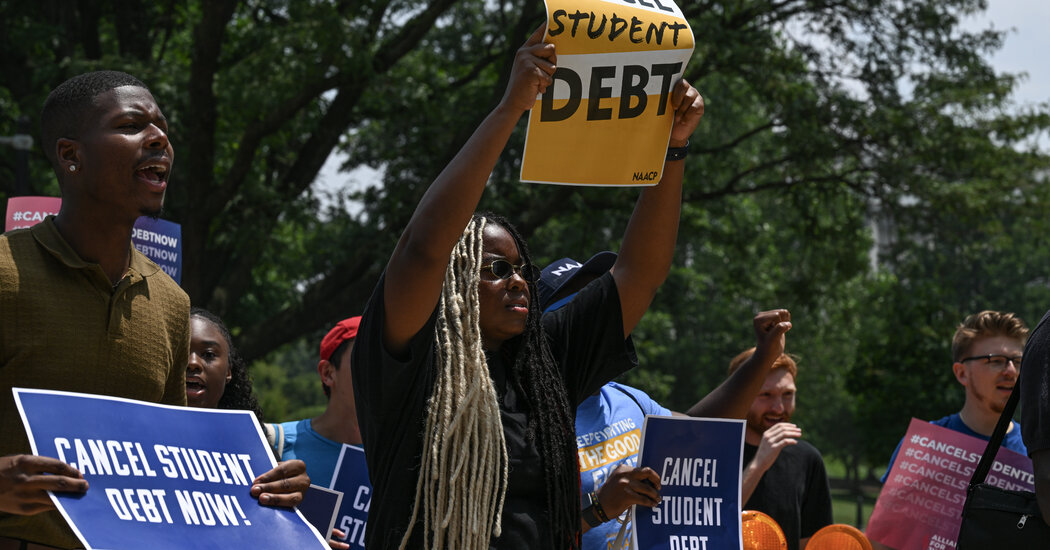President Biden’s new student loan repayment plan was hobbled on Monday after two federal judges in Kansas and Missouri issued separate rulings that temporarily blocked some of the plan’s benefits, leaving questions about its fate.
The preliminary injunctions, which suspend parts of the program known as SAVE, leave millions of borrowers in limbo until lawsuits filed by two groups of Republican-led states challenging the legality of the plan are decided.
That means the Biden administration cannot reduce borrowers’ monthly bills by as much as half starting July 1, as had been scheduled, and it must pause debt forgiveness to SAVE enrollees. The administration has canceled $5.5 billion in debt for more than 414,000 borrowers through the plan, which opened in August.
If you’re among the eight million borrowers making payments through SAVE — the Saving on a Valuable Education plan — you probably have many questions. Here’s what we know so far, though the Education Department has yet to release its official guidance.
Let’s back up for a minute. What does SAVE do?
Like the income-driven repayment plans that came before it, the SAVE program ties borrowers’ monthly payments to their income and household size. After payments are made for a certain period of years, generally 20 or 25, any remaining debt is canceled.
But the SAVE plan — which replaced the Revised Pay as You Earn program, or REPAYE — is more generous than its predecessor plans in several ways.
Once fully in place, the plan would have reduced payments for undergraduate borrowers to 5 percent of their discretionary income, from 10 percent. (People with graduate debt pay 10 percent of discretionary income, and borrowers with both types would have payments weighted accordingly.)
SAVE also allows borrowers to exclude more of their earnings from their payment calculation, and shortened the repayment period for borrowers with smaller loan balances.
What benefits of SAVE were halted by the rulings?
SAVE’s components were being rolled out in phases, and pieces that are not already in effect were put on hold (because of the Kansas judge’s ruling). They include the reduction in payments to 5 percent of discretionary income from 10 percent, which was scheduled to take effect on July 1.
The Missouri judge’s order blocks any new debt cancellation achieved through the SAVE program. But borrower advocates and student loan experts said this part of the ruling was ambiguous, and it was unclear how widely this provision should be interpreted.
A spokeswoman for the Education Department said it was still reviewing the rulings.
SAVE also provides a shorter path to loan cancellation for enrollees with smaller loan balances. But that benefit will no longer work for those with debt remaining at the end of that abbreviated term — which may be as short as 10 years — now that the judge in Missouri has blocked forgiveness.
What components of SAVE will remain?
If you’re enrolled in SAVE, your payment appears unlikely to change for now.
The SAVE plan had already lowered payments because its formula lets borrowers keep more of their earnings to pay for basic needs, shielding it from the repayment formula.
As it stands, borrowers (with undergraduate or graduate debt) pay 10 percent of their income above that protected amount, or 225 percent of the poverty level. (That means single people who earn roughly $15 an hour or less will no longer need to make any payment at all.) Under the earlier REPAYE plan, borrowers paid 10 percent of income above 150 percent of the federal poverty guidelines. The more generous threshold remains.
Interest treatment. The SAVE plan’s favorable treatment toward interest also appears to be unaffected by the court rulings for now. In other words, if a borrower’s monthly payment does not cover all of the interest owed that month, the Education Department will continue to waive the uncovered portion, preventing the debt from growing, at least for the moment.
“While we continue to review these rulings, the SAVE plan still means lower monthly payments for millions of borrowers,” Education Secretary Miguel Cardona said in a statement, “including more than four million borrowers who owe no payments at all, and protections for borrowers facing runaway interest when they are making their monthly payments.”
If I’m already enrolled in SAVE, what happens now?
You can remain enrolled in SAVE and keep your current monthly payment, even if it’s $0 (which more than four million lower-income borrowers qualify for).
Can I still enroll in SAVE if I haven’t already?
Yes.
“While we are assessing the rulings, borrowers can still enroll in the SAVE plan,” the office of Federal Student Aid states on its website. “We will be sharing more information with borrowers soon.”
My loans were put in an administrative forbearance while my SAVE payment was adjusted. What happens now?
Millions of borrowers were set to have their loan amounts reduced after the SAVE plan’s final provisions took effect on July 1, but their loan servicers placed them in an administrative forbearance while it calculated those new monthly payments.
Since that payment reduction has been blocked, it’s unclear what happens next. But it’s reasonable to assume that payments will remain the same — that is, at amounts using only the more generous discretionary income formula. But it could take some time for the loan servicers to work that out and for payments to resume.
What if I’m making payments through the SAVE plan but also enrolled in the Public Service Loan Forgiveness program?
The ruling in Missouri prevents new loan forgiveness under SAVE.
But student loan experts said they did not believe that affected borrowers who are making payments through SAVE but are also enrolled in the Public Service Loan Forgiveness program, which can eliminate the balances of qualifying public-sector and nonprofit workers after 120 payments.
“It does not block P.S.L.F.,” said Mark Kantrowitz, a student financial aid expert, and “it does not retroactively block forgiveness already provided.”
If these rulings occurred in just two states, why do they hold nationwide?
The federal judge in Kansas, Daniel D. Crabtree, said earlier this month that only three states in the suit there — South Carolina, Texas and Alaska — had the legal standing to sue. And Judge Crabtree declined to unwind the pieces of the SAVE plan that were already operational.
But, in his order, he wrote that “a broad rule, like the SAVE plan, requires a broad injunction, given the compelling need for nationwide uniformity in the department’s administration of student loan programs.”
What does the Biden administration plan to do?
It clearly disagrees with the District Court decisions, noting that the Education Department has relied on its authority under the Higher Education Act three times over the last 30 years to introduce income-driven repayment plans.
“The Department of Justice will continue to vigorously defend the SAVE plan,” Mr. Cardona said in his statement.





